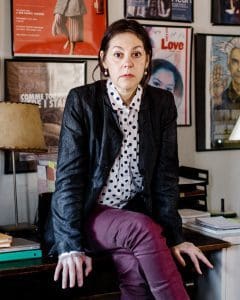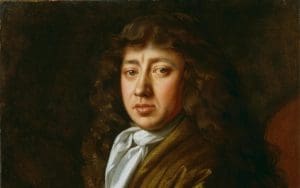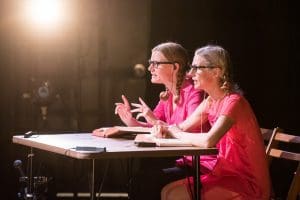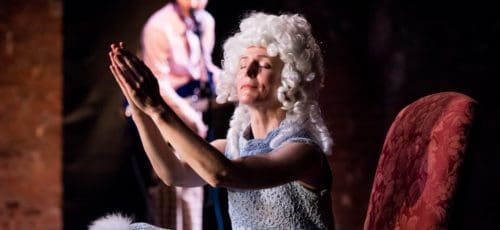Big Dance Theater takes on Samuel Pepys: Interview with Annie-B Parson
“In the last few years, what has become important is the uncensored rendering of his bullying, his shame around his behavior and yet his complete lack of awareness of the violence of his actions.”
From Mark Twain to Euripides, Big Dance Theater is well known for their innovative and unexpected ways of using of literary sources for inspiration. Diligent but whimsical in how they combine the old and the new, they’ve been called “historically promiscuous” by producer David White. In their latest creation, 17c (coming to the 2017 Fringe Festival), co-artistic directors Annie-B Parson and Paul Lazar took the diaries of Samuel Pepys as the source of inspiration and investigation in this ensemble work of dance, theater, and music. Throughout 17c, a distinctly feminist voice is interwoven with his words, gathered from the writings of his contemporary, and from a desire to give voice to those who are historically voiceless, most notably Pepys’s wife. We caught up with Annie-B Parson about the inspiration and process of creating 17c.
FringeArts: Do you remember how the title 17c came into being?
Annie–B Parson: The titling of this piece has been an epic story. As the world has changed around us during the two-year span of creating it, the title has changed at least twenty times! Lists and lists of ideas for titles have been generated and circulated; they have ranged from a title which puts pressure on the piece to prove something, to a title that sounds great to see and say, to the simple naming of a fact. On the day the deadline came to title it for the premiere, we liked the simple efficiency of 17c, which supports the formal nature of the material as well. And, as one work is always a response to the work that precedes it, 17c was reactive to our last title, which was cumbersome and obscure.
FringeArts: What first drew you to Pepys as material that might work for the stage?
Annie–B Parson: As someone who is hyper-generative, I am always drawn to others who are also can’t stop making things. Pepys had to write, he was miserable when he missed a day, and this act of getting it down, of recording every little boil on his body, every encounter and feeling around the encounter, made me feel a kinship with him. And, it was amazing when first encountering these diaries, that 350 years ago, dance and theater were so valued. Eureka! I felt vindication in this figure who found dance a worthy daily practice, who valued the dance in theater, and who felt dance would better his standing. And, I loved that this person was so enamored of theater that he would need to quit it from time to time, much like he would quit drinking! I was also drawn to how contemporary he seemed, how trendy, so involved with his clothing, fretting about each outfit—when to wear a new coat, in what situation his new sleeves would have the best effect, etc. This was my first reading of the diaries about ten years ago.
But in the last few years, what has become important is the uncensored rendering of his bullying, his shame around his behavior and yet his complete lack of awareness of the violence of his actions. The absence of the voice of his wife Bess disturbed me more and more, and I began to suspect that he had burned her diaries, thereby silencing her to history. I searched for a female theatrical voice from that time to balance and testify to a feminism that was occurring then, but has been lost. This led me to the obscure radical feminist writer, Margaret Cavendish. To my delight, Pepys had encountered her a few times on the street, as she was a bit of a bad-girl celeb.
FringeArts: What made the other source materials you brought into the show—namely Margaret Cavendish’s play—work for you?
Annie–B Parson: I have always dragged the past into the present, as one cannot exist without the other. David White called the work of Big Dance “historically promiscuous”—and it’s true. I am not interested in linear reality as such, but in a relational reality, one that is elastic and poetic. I read quite a few women’s plays from that time, hoping to stage a play within a play. Margaret Cavendish’s work leapt out at me for its directness and its politics. Cavenidish’s writing was underground at the time, her plays were “closet plays” meaning there was no intention for them to be produced; as a woman, this was an impossibility. But she sustained a prolific writing life and her work speaks to her radical feminist stance. I feel she is owed many, many productions of her work to right the inequality of exposure, and our rendering is part of that re-balancing. It’s not that different today by the way. We are now seeing a few women playwrights on Broadway, and personally, though my work is produced, I am erased in subtle but systemic ways. I feel a kinship with Cavendish for sure.
FringeArts: How did the Book Nerds characters come about?
Annie–B Parson: I was researching the diary and came upon this vast on line community of Pepys fans who read the diary entry for the day and then comment on it online. I immediately heard the voice of one of our performers, Kourtney Rutherford, saying these words in my head and sent her the daily diarylink to see her response. These online comments are not just historical details that add context to the entries, but they get quite personal and strange. And these people come to know each other well. It was a goldmine of text for us. I also commissioned a funny and brainy astrologist blogger to read the diaries and blog about them. This provided additional text.
FringeArts: What were you discussing the most during rehearsal with performers and fellow creators?
Annie–B Parson: We don’t talk about content in rehearsal; our discussions center around doing—crafting material. If I may generalize, I think this is a typical difference between dance and theater. Theater people sit around a table and discuss meaning and content for a week typically before they start. Dance people get on their feet and sweat the ideas out. I believe this makes the material of the work ultimately more prismatic and unpredictable, and allows ambiguity to sneak in. I say this knowing there are exceptions!
FringeArts: I am curious about the ideas of past and present.
Annie–B Parson: A long time ago the past was the present. Time is a construct (just like dance). As Dylan said: “When did we last see each other? I think it was in ancient Greece.”
17c
Big Dance Theater
Special Preview Performances
Sept 7 at 7pm (Festival Opening Night, $75 ticket includes after party with drinks and passed hors d’oeuvres.)
Sept 8 at 8pm (Festival Kick Off with Ill Doots concert following the show)
Sept 9 at 2pm + 8pm
$29 (general) // $20.30 (member) // $15 (student + 25-and-under)
TICKETS & INFO
FringeArts
140 North Columbus Boulevard (at Race)
Wheelchair accessible
85 minutes
—Interview by Josh McIlvain. Additional writing by Isabella Siegel.






